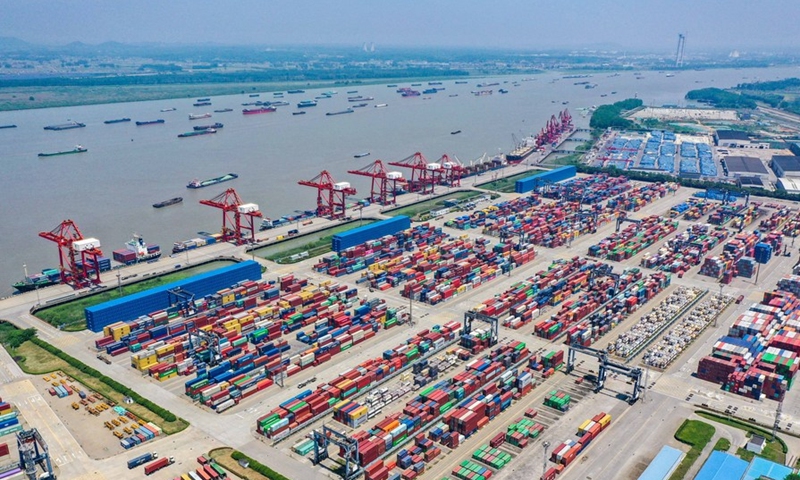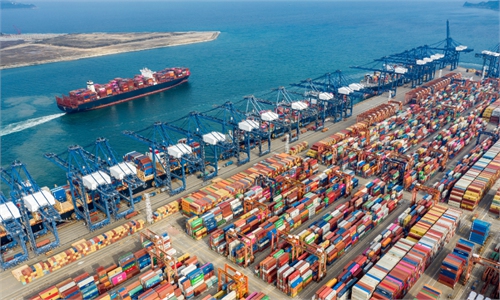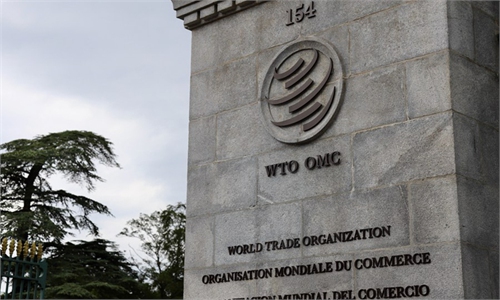China’s foreign trade up 8.6% in Jan-Nov despite challenges; strong rebound expected
Challenges persist, but strong rebound expected: experts

Aerial photo taken on May 6, 2022 shows a view of the Longtan Container Terminal of Nanjing Port in Nanjing, Jiangsu Province. Photo: Xinhua
China’s foreign trade staged strong growth of 8.6 percent year-on-year in the first 11 months of 2022 despite mounting challenges including weak overseas demand, growing geopolitical tensions and COVID-19 resurgences, customs data showed on Wednesday.
While the country’s export growth rate slowed in November due to a variety of complex factors, experts expressed optimism for the prospects of China's trade sector in 2023, pointing to the steady recovery of the economy following the easing of anti-epidemic restrictions, which will also help boost global economic recovery.
According to data from the General Administration of Customs (GAC), China’s foreign trade reached 38.34 trillion yuan ($5.49 trillion) in yuan-denominated terms between January and November, up 8.6 percent on a yearly basis.
Exports rose by 11.9 percent to 21.84 trillion yuan, while imports grew by 4.6 percent year-on-year to 16.5 trillion yuan.
ASEAN was China’s largest trading partner during the period, with bilateral trade up 15.5 percent. China’s trade with the EU – its second-largest trade partner – grew 7 percent, while trade with the US was up 4.8 percent, according to the customs data. Trade with Belt and Road Initiative economies jumped 20.4 percent year-on-year to 12.54 trillion yuan.
In November alone, China’s exports grew 0.9 percent year-on-year, an apparent slowdown compared with the previous month’s reading of 7 percent year-on-year. Meanwhile, imports declined 1.1 percent year-on-year last month, down 7.9 percentage points from October, according to the GAC.
“The unexpected slower growth in imports and exports was mainly due to a higher base last year, as well as declining demand overseas and sporadic COVID-19 resurgences that disrupted manufacturing,” Zhou Maohua, an economist at Everbright Bank, told the Global Times on Wednesday.
Because of higher inflation, many people are less willing to spend, while interest rate hikes have had a negative impact on investment, which in turn reduced demand for raw materials and other products, Hu Qimu, deputy secretary general of the digital-real economies integration Forum 50, told the Global Times.
However, China’s foreign trade still showed strong resilience, with the structure continuing to optimize and vehicle exports maintaining strong momentum.
According to the GAC, general trade maintained double-digit growth of 12.4 percent in the first 11 months to hit 24.47 trillion yuan, accounting for 63.8 percent of the country’s total trade.
In the first 11 months, China exported vehicles worth 363.76 billion yuan, up 79.3 percent year-on-year.
Tian Yun, a veteran macroeconomist, said that China’s trade performance is still very strong compared with other major exporters like Japan.
Tian predicted that China's trade might still face some difficulties in the first half of next year, as the yuan will get stronger amid expectations for an economic rebound following the easing of epidemic control measures. Besides, the US might continue to add tariffs on targeted Chinese goods like steel, and China should prepare countermeasures.
Still, Tian stressed that if the US stops hiking interest rates next year, it would greatly ease global liquidity, particularly for the real estate sector, and China's export pressure will also be largely reduced.
Hu is more optimistic about the prospects of China's trade sector. He said that the trade numbers should stabilize in the first quarter of next year, as the easing of anti-epidemic measures will drive up internal demand, which will be beneficial to import growth. The recovery of the Chinese economy will also provide strong momentum for the global economic recovery, which will boost cross-border investment and trade as well.
Along with the continuous optimization of COVID-19 response measures, China has been stepping up measures to stabilize foreign trade.
At a press briefing on November 12, An Baojun, an official at the Ministry of Commerce, said that the ministry will encourage local commerce authorities to improve the white-list mechanism, and improve their support and facilitation for export-oriented businesses to ensure their normal manufacturing and smooth logistics.
Meanwhile, amid the robust momentum of car exports, Chinese authorities issued a notice on Tuesday allowing another 14 regions, including Northeast China’s Liaoning, East China’s Fujian and Southwest China’s Sichuan Province, to export secondhand cars.
While the country’s export growth rate slowed in November due to a variety of complex factors, experts expressed optimism for the prospects of China's trade sector in 2023, pointing to the steady recovery of the economy following the easing of anti-epidemic restrictions, which will also help boost global economic recovery.
According to data from the General Administration of Customs (GAC), China’s foreign trade reached 38.34 trillion yuan ($5.49 trillion) in yuan-denominated terms between January and November, up 8.6 percent on a yearly basis.
Exports rose by 11.9 percent to 21.84 trillion yuan, while imports grew by 4.6 percent year-on-year to 16.5 trillion yuan.
ASEAN was China’s largest trading partner during the period, with bilateral trade up 15.5 percent. China’s trade with the EU – its second-largest trade partner – grew 7 percent, while trade with the US was up 4.8 percent, according to the customs data. Trade with Belt and Road Initiative economies jumped 20.4 percent year-on-year to 12.54 trillion yuan.
In November alone, China’s exports grew 0.9 percent year-on-year, an apparent slowdown compared with the previous month’s reading of 7 percent year-on-year. Meanwhile, imports declined 1.1 percent year-on-year last month, down 7.9 percentage points from October, according to the GAC.
“The unexpected slower growth in imports and exports was mainly due to a higher base last year, as well as declining demand overseas and sporadic COVID-19 resurgences that disrupted manufacturing,” Zhou Maohua, an economist at Everbright Bank, told the Global Times on Wednesday.
Because of higher inflation, many people are less willing to spend, while interest rate hikes have had a negative impact on investment, which in turn reduced demand for raw materials and other products, Hu Qimu, deputy secretary general of the digital-real economies integration Forum 50, told the Global Times.
However, China’s foreign trade still showed strong resilience, with the structure continuing to optimize and vehicle exports maintaining strong momentum.
According to the GAC, general trade maintained double-digit growth of 12.4 percent in the first 11 months to hit 24.47 trillion yuan, accounting for 63.8 percent of the country’s total trade.
In the first 11 months, China exported vehicles worth 363.76 billion yuan, up 79.3 percent year-on-year.
Tian Yun, a veteran macroeconomist, said that China’s trade performance is still very strong compared with other major exporters like Japan.
Tian predicted that China's trade might still face some difficulties in the first half of next year, as the yuan will get stronger amid expectations for an economic rebound following the easing of epidemic control measures. Besides, the US might continue to add tariffs on targeted Chinese goods like steel, and China should prepare countermeasures.
Still, Tian stressed that if the US stops hiking interest rates next year, it would greatly ease global liquidity, particularly for the real estate sector, and China's export pressure will also be largely reduced.
Hu is more optimistic about the prospects of China's trade sector. He said that the trade numbers should stabilize in the first quarter of next year, as the easing of anti-epidemic measures will drive up internal demand, which will be beneficial to import growth. The recovery of the Chinese economy will also provide strong momentum for the global economic recovery, which will boost cross-border investment and trade as well.
Along with the continuous optimization of COVID-19 response measures, China has been stepping up measures to stabilize foreign trade.
At a press briefing on November 12, An Baojun, an official at the Ministry of Commerce, said that the ministry will encourage local commerce authorities to improve the white-list mechanism, and improve their support and facilitation for export-oriented businesses to ensure their normal manufacturing and smooth logistics.
Meanwhile, amid the robust momentum of car exports, Chinese authorities issued a notice on Tuesday allowing another 14 regions, including Northeast China’s Liaoning, East China’s Fujian and Southwest China’s Sichuan Province, to export secondhand cars.




